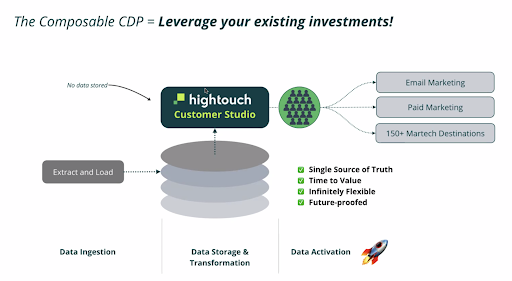Customer Data Platforms (or CDPs for short) have been popular in the market for some time now, but the category truly came to full fruition around 2016-2017.
As the category formed, some CDP vendors evolved from other existing business products and others started as pure CDPs, even the marketing clouds took notice of this fast emerging category. Today, the CDP is an established global category recognized by Forrester and Gartner, and has a thriving ecosystem of vendors with varying viewpoints and capabilities.
Recently, a new paradigm has emerged in the CDP world – the rise of the unbundled (also referred to as composable) CDP! Unbundled CDPs offer brands a unique kind of flexibility in handling customer data. They take a modular approach, allowing businesses to build on top of their existing data infrastructure, giving a more configurable approach to implementation. Unlike packaged CDPs that require a unique implementation and unification of different data sources, a composable CDP sits on top of a company’s data platform which also makes it more seamless to manage complex pieces like marketability and data governance.

So let’s go deeper into understanding why this CDP paradigm is called the ‘composable’ CDP. Realistically, you may not need all the features and functionality of a packaged customer data platform. A traditional CDP requires a built-in data ingestion framework, which may not be necessary if your data is already successfully being ingested into your data warehouse. That brings us to the most important differentiation of the composable CDP – the data layer.
In traditional CDPs (often called packaged CDPs), data across your organization is ingested by the CDP into its own data layer. The packaged CDP then unifies the data into a customer 360 and makes it available to the marketer in a user-friendly UI for segmentation, journey management and omni-channel activation (often called the audience layer). In an unbundled CDP, the idea is that there is no separate data layer to the CDP – it sits on top of your existing data layer – Snowflake, Databricks, Bigquery, etc. – and provides the audience layer on top of the data management system. This is the biggest difference between traditional/packaged CDPs and unbundled CDPs.
There are a few reasons why the approach of a composable CDP is getting so much interest and attention, and why we at Artefact think that this approach is a powerful design paradigm that customers can consider:
Here are some examples of unbundled/composable CDPs, and some of their salient features:
Artefact First and Second Party Data Lead, Amit Erande, sees clear value and differentiation with the unbundled CDP space as well,“Having been part of the CDP category since it’s inception, I see the unbundled CDP as a natural extension to the CDP options available to brands. With the advent of powerful cloud data warehouses and data lakes such as Snowflake, Databricks and Bigquery, unbundled CDPs provide an efficient and complementary means to maximize the value of your customer data ecosystem.”
This new era of Composable Customer Data Platforms represents a pivotal moment in the evolution of data management. As businesses navigate an increasingly complex and dynamic landscape, the adaptability and agility offered by Composable CDPs emerge as an increasingly attractive option. For certain organizations, the modular flexibility of Composable CDPs is the key to unlocking the full potential of your customer data.

 BLOG
BLOG






